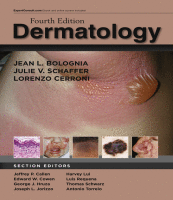Physical Address
304 North Cardinal St.
Dorchester Center, MA 02124

Small Plaque Parapsoriasis Synonyms ▪ Parapsoriasis en plaques ▪ Chronic superficial [scaly] dermatitis ▪ Digitate dermatosis (variant) ▪ Xanthoerythrodermia perstans (variant) Key features ▪ Chronic, asymptomatic, erythematous scaly patches ▪ Lesions are generally <5 cm in diameter or digitate ▪ Histologically,…

Key features ▪ Psoriasis is a chronic, immune-mediated disorder that results from a polygenic predisposition combined with environmental triggers, e.g. trauma, infections, medications, psychological stress ▪ The underlying pathophysiology involves various classes of T cells and their interactions with dendritic…

Introduction “Psychodermatology” refers to any aspect of dermatology in which psychological factors play a significant role. At least a third of patients seen in dermatology practices require consideration of associated emotional and psychosocial factors for effective management of their skin…

Introduction Pruritus can be defined as an unpleasant sensation that elicits a desire to scratch. The presumed biologic purpose of pruritus is to provoke scratching to remove a parasite or other harmful pruritogen. Pruritus is the most common skin-related symptom.…

Key features ▪ Two subsets of pruritoceptive C neurons that respond to histamine versus cowhage and then activate distinct spinothalamic tract neurons ▪ Peripheral itch mediators include histamine, proteases, and interleukin-31, while central itch mediators include opioids, gastrin-releasing peptide, and…

Key features ▪ The major purpose of the immune system is protection against harmful organisms. This is achieved by a rapid “primitive” reaction, called the innate immune response, and a more highly developed specific reaction, called the adaptive immune response…

Introduction Advances in molecular biology are rapidly changing our understanding of skin biology and disease. Increased knowledge is being translated into new molecular diagnostic tests that are transforming the clinical practice of dermatology. Molecular analyses are currently being employed to…

Introduction Development of the human embryo is a complex process involving highly orchestrated cell movements, proliferation, death, and differentiation. This chapter focuses on key events and regulatory mechanisms that result in skin morphogenesis, maintenance, and regeneration. The spectrum of cutaneous…

Key features ▪ The relationship between function and structure of the skin is best demonstrated by presenting diseases that illustrate how skin can fail. Thus, disease reveals function, and function illustrates structure ▪ The most obvious function of skin is…

Introduction to Clinical Dermatology The skin represents the largest organ of the human body. The average adult has 1.75 m 2 (18.5 ft 2 ) of skin that contains a variety of complex adnexal structures, including hair follicles, nails, glands and specialized…